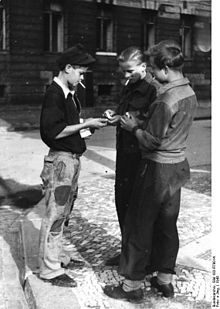Cigarette currency
Cigarette currency was a term used on the black market in post-war Germany .
Since after the war the Reichsmark (RM) in Germany, which was occupied by the Allies , constantly lost its value due to inflation , the direct exchange of goods became increasingly popular with the people. The value comparison function (one of the money functions ) was also taken over by goods - mainly cigarettes ; these were extremely scarce and traded with pleasure. The "cigarette currency" was common. In October 1946, one cigarette was equivalent to a monetary valuedepending on the location from around 2.50 to 10 RM, which would correspond to today's purchasing power of 9 to 34 euros. The prices in Berlin with its Soviet-occupied area were almost twice as high as in southern Germany, where more supplies were possible thanks to the US occupation.
With the currency reform on June 20, 1948 in the western zones and the currency reform in the Soviet occupation zone on June 23, 1948 , the situation normalized again.
literature
- Christoph Maria Merki: The American cigarette - the measure of all things. Smoking in Germany at the time of the cigarette currency (1945–1948). In: Thomas Hengartner, Christoph Maria Merki (Hrsg.): Tobacco issues. Smoking from a cultural studies point of view. Zurich 1996, pp. 57-82.
Web links
Individual evidence
- ↑ Willi A. Boelcke: The black market 1945–1948: On survival after the war . Georg Westermann Verlag, 1986, ISBN 3-07-508814-5 , p. 106.
- ↑ Bernd Sprenger: 60 Years of Currency Reform - 1948 and the Economic Policy Consequences . (PDF) In: Bernd Sprenger, Bodo Herzog: Currency reform and social market economy. Berlin 2008, ISBN 978-3-940955-10-4 , pp. 7-27.
- ^ Cigarette currency . In: The time . No. 20/1948.
